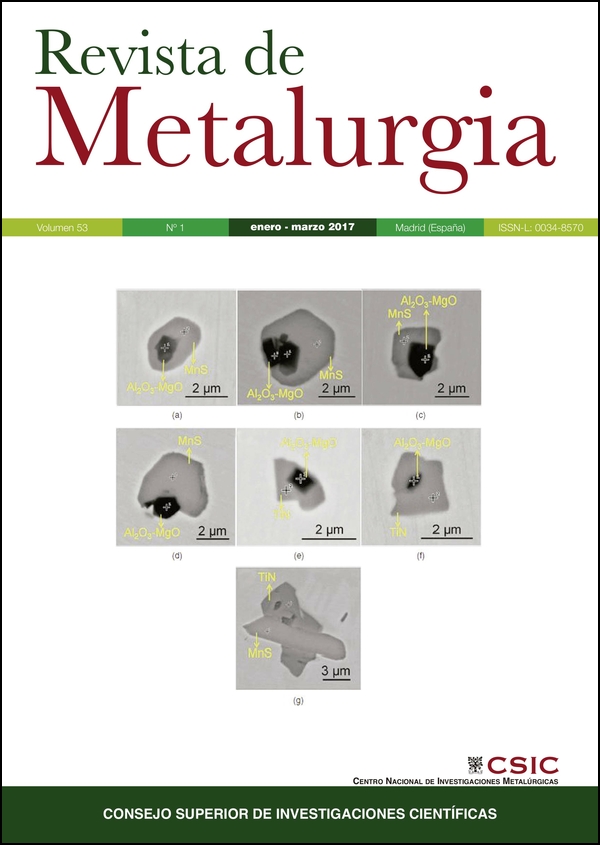Effect of repressing on the mechanical properties of the valve guides manufactured by powder metallurgy
DOI:
https://doi.org/10.3989/revmetalm.087Keywords:
Friction coefficient, Hardness, Mass loss, Repressing effectAbstract
Characterization of hardness, mass loss, and friction coefficient, was carried out on valve guides for internal combustion engines, manufactured by powder metallurgy, with the aim of finding out if they fulfill the requirements of an internal combustion engine and to be mass produced. Currently available brass casting valve guides were used as comparative parameter. It was analyzed whether properties were present in a homogeneous way in the piece lengthwise; the additional repressing process carried out in the production line with respect to the sintered guides was evaluated. Therefore, Brinell, Vickers and dry slip pin-on-disk tests were done in order to determine the friction coefficient and the wear rate. Scanning electron microscopy SEM and the metallographic analysis were used to study the wear mechanism, chemical composition of the guides, and the effect of repressing -quantifying the porosity. It was clear that these pieces manufactured by powder metallurgy process showed lower values in their mechanical-tribological properties compared to commercially available valve guides taken as reference. With these results, the company which manufactures the guides by powder metallurgy will make some adjustments suggested for the parameters at the guide’s production line.
Downloads
References
Abdizadeh, H., Ebrahimifard, R., Baghchesara, M.A. (2014). Investigation of microstructure and mechanical properties of nano MgO reinforced Al composites manufactured by stir casting and powder metallurgy methods: A comparative study. Compos. Parte B-Eng. 56, 217–221. https://doi.org/10.1016/j.compositesb.2013.08.023
ASTM G99-05 (2000). Standard Test Method for Wear Testing with Pin-on-Disk Apparatus, ASTM International, West Conshohocken, PA, USA.
ASTM E10-12 (2012). Standard Test Method for Brinell Hardness of Metallic Materials, ASTM International, West Conshohocken, PA, USA.
ASTM E92-82 (2003). Standard Test Method for Vickers Hardness of Metallic Materials, ASTM International, West Conshohocken, PA, USA.
De Garmo, E.P., Black, J.T., Kohser, R.A. (2002). Pulvimetalurgia, en Materiales y procesos de fabricación. Vol. I, 2da Edition, Reverté S.A, Barcelona, pp. 371–386.
Dietsche, K. (2005). Manual de la técnica del automóvil. Motor de émbolo de combustión interna, 4ta Edition, Bosch, Alemania, pp. 451–469.
Fujiki, A. (2001). Present state and future prospects of powder metallurgy parts for automotive applications. Mater. Chem. Phys. 67, 298–306. https://doi.org/10.1016/S0254-0584(00)00455-7
Gonzales Calleja, D. (2015). Motores térmicos y sus sistemas auxiliares. Elementos Constructivos, 2da Edition, Ediciones Paraninfo S.A., Madrid, pp.105–110.
Groover, P. (1997). Fundamentos de Manufactura Moderna: Materiales, Procesos y Sistemas. Metalurgia de Polvos, 1ra Edition, Prentice Hall, Naucalpán de Juárez, pp. 393–415.
Jabur, A.S. (2013). Effect of powder metallurgy conditions on the properties of porous bronze. Powder Technology 237, 477–483. https://doi.org/10.1016/j.powtec.2012.12.027
Jang, G.B., Hury, M.D., Kang, S.A. (2000). A study on the development of a substitution process by powder metallurgy in automobile parts. J. Mater. Process. Technol. 100 (1–3), 110–115. https://doi.org/10.1016/S0924-0136(00)00426-X
Keraghel, F., Loucif, K., Delplacke, M.P. (2011). Study of bronze porous alloy Cu-Sn Worked out by metallurgy of the powder. Phys. Procedia 21, 152–158. https://doi.org/10.1016/j.phpro.2011.10.023
Martin, F., García, C., Blanco, Y. (2015). Influence of residual porosity in the dry and lubricated sliding wear of a powder metallurgy austenitic stainless steel. Wear 328–329, 1–7. https://doi.org/10.1016/j.wear.2015.01.025
Mott, R.L. (2006). Dise-o de elementos de máquinas. Cap. Materiales en el dise-o mecánico, 4ta Edition, Pearson Educación, Naucalpán de Juárez, p. 56.
ProExport (2102). Incentivos del sector automotriz. Colombia. (Acceso febrero 2017). http://inviertaencolombia.com.co/publicaciones/incentivos-del-sector-automotriz-2016.html.
Schmid, S.R., Kalpakjian, S. (2002). Manufactura, Ingeniería y Tecnología. Procesamiento de metales en polvo, cerámicos, vidrio y superconductores, 4ta Edition, Prentice Hall, Naucalpan de Juárez, pp. 440–460.
Published
How to Cite
Issue
Section
License
Copyright (c) 2017 Consejo Superior de Investigaciones Científicas (CSIC)

This work is licensed under a Creative Commons Attribution 4.0 International License.
© CSIC. Manuscripts published in both the printed and online versions of this Journal are the property of Consejo Superior de Investigaciones Científicas, and quoting this source is a requirement for any partial or full reproduction.
All contents of this electronic edition, except where otherwise noted, are distributed under a “Creative Commons Attribution 4.0 International” (CC BY 4.0) License. You may read the basic information and the legal text of the license. The indication of the CC BY 4.0 License must be expressly stated in this way when necessary.
Self-archiving in repositories, personal webpages or similar, of any version other than the published by the Editor, is not allowed.
















